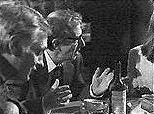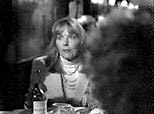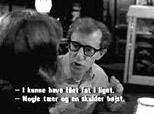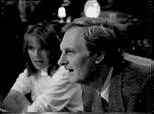A picture initially is atemporal and will remain so unless the discourse assigns it a temporal reference; nevertheless, a picture invariably discloses its spatial determinations for the reason that the picture must necessarily be taken from some angle and location (p. 45).A similar outlook can be found in Bazin's view of the relation between film and reality (Bazin 1961). In contrast to Branigan's semiotic approach in his book on subjectivity in film, we find here a pre-semiotic idea - conceiving of film art as either realism or formalism. Branigan's point raises a question: Does film space, as a part of visual style, produce meaning or is it only a kind of patterned vehicle, an ornamental characteristic of the film narrative? It is common knowledge that space is one of the stylistic features of film and television and that space influences our reception of the film narrative. Editing, camera movements, close ups, long shots, etc., determine the rhythm and duration of a film narrative, and therefore influence the sense we make of the narrative.
For this paper I have selected the topic visual space as a contribution to the
ongoing discussion of film style - a discussion resulting from Bordwell's
reflections in his neoformalistic Narration in the Fiction Film (1985).
It is hypothetical. If one of them should wake up and pull the cord... ding-a-ling, the alarm goes off in the guard room and you call for a doctor at the main building. You are not allowed to do anything yourself. Just call - but it could never happen.  The composition of the shot creates a great distance between the two men. Morten is placed at the right foreground - blurred and in silhouette - while the old night watchman is situated in the background of the shot, approximately in the middle of the frame. The preceding shots have shown us the two men in medium and medium close ups - the young one interested in the spooky stories told by the old night watchman. Now we see them in a medium large shot created by the photography and staging. Seen as a relation of space, the distance between them is created by two stylistic features: cinematography and mise-en-scène. The old night watchman denies to his young replacement that the dead bodies could ever wake up but if it should happen...! As a consequence of the composition of the shot, his small size tells us what we now think is going to happen in the immediate future: the alarm will go off, but who will release it and why? The visual expression creates the content of the shot - a warning about something that cannot happen but eventually will occur. The meaning of the shot is also created in a way that either can reinforce it or have less influence on it. The meaning of the shot is reinforced in The Night Watchman because of the shift of style from the preceding shots to the scene in the refrigerating room. The preceding shots are edited in a smooth rhythm while the shots of the refrigerating room are edited statically. The pattern of style has changed. The shots from the refrigerating room show a larger space and are staged in a different way. In contrast to the preceding shots in which the old night watchman dynamically gives the young hero a quick tour of the premises, he is now "forced" up against the wall in the refrigerating room. The change in pace is so emphasized that the viewer can't overlook it. The style creates meaning and functions as an emotional presupposition, driving the viewer to feel anxious and insecure, thereby giving the film its thrilling quality.
It is very difficult to distinguish between the visual expression creating
meaning and the same expression seen as a stylistic pattern, only reinforcing
the story events, and at the same time operating as an emotional
presupposition. I raise this problem because it seems to have been solved by
David Bordwell in his neoformalistic approach.
For example, crosscutting is a type of composition creating meaning, but at the same time it is a special stylistic way of editing. In Bordwell's approach, these are two different aspects of the reception process but interrelated textual functions. It is a syuzhet strategy - the information is constructed in a sequence creating the viewer's expectations and it is a stylistic pattern of close ups, mediums shots, formed in a special rhythm. The stylistic pattern can support the points of the syuzhet or it can be self-conscious in relation to the syuzhet. Though the viewer may not always see the pattern of style, it is nevertheless identifiable from an analytical position. For example the close ups of Dreyer's Jeanne d'Arc make a pattern of systematically applied cinematic devices. Also in more classical films, we can describe the stylistic pattern as the fundamental approach to the information of the syuzhet, although the classical style is almost "invisible".
It is to Bordwell's credit that he distinguishes between the creation of fabula
(meaning) and style as a purely formal category. In the early days of film
theory, those two dimensions of the film were combined in the concept of film
form. For example, the French writer André Bazin conceived of style as
being the means for achieving the film form. The raw material of cinema is made
to "signify" through various means when it finds its form. Bordwell's
neo-formalism gives us the opportunity to study the visual dimension of any
film as an independent subject before we relate it to the meaning of the film.
There are two scenes at different restaurants in Woody Allen's Manhattan Murder Mystery (1993) - one at the beginning of the film and one near the end. In the first restaurant scene, we meet the two leading characters, Larry (Woody Allen) and Carol (Diane Keaton), friend Ted (Allan Alda), and two other friends. During the dinner, they discuss the death of the neighbor's wife. The intimate mood is emphasized by two stylistic devices: camera movement and the closeness of the camera. The lighting is low key, the camera moves around the table, and the characters appear in two-shots or one-shots.
The two stills show us that the heads of the characters fill most of the frame, and together with camera movements, that gives us an impression of intimacy in the conversation around the table. There is no editing at all. Only camera movements make the change in point of view. The camera movements emphasize the rhythm of the conversation in which friends interrupt each other as they discuss the death of the neighbor's wife, while at the same time making remarks about the danger of the high cholesterol dessert. Instead of the traditional stylistic option - shot-reverse-shot between speaking characters - Allen has chosen camera movement as the dominant stylistic device (as he does for many of the scenes in this film). It makes the rhythm of the conversation more fluent than shot-reverse-shot, and furthermore the camera movements are so visible that the spectator is likely to be aware of the self-conscious narration they represent. While the camera movements are self-conscious narration, they also create the space in which the characters perform their acts. It is a restaurant, of course, but the spectator must be convinced since there are no establishing shots at all. However the shots contain enough information for the spectator to form the inference that there is more space than meets the eye. A waiter passes the camera and goes on to a space not seen; the sound of restaurant noise contributes to the spectator's forming a hypothesis about a larger space than appears in the shots. Also the jazz tune, Take Five by Dave Brubeck, enlarges the space in a more abstract direction. We sense a space (absent in the frame) much larger than the space revealed by the shots (present in the frame). The presentation of space by means of stylistic devices - music, noise, camera movements, decorations and lighting - creates the difference between the larger space and the more intimate space as a presupposition for the small talk about the death of the neighbor's wife, mixed with babbling about cholesterol desserts. With different consequences, some of the same stylistic devices are used in the other restaurant scene as well. Larry, Carol, Ted and the female author, Marcia (Angelica Houston), are convinced that the neighbor (Mr. House) has murdered an unknown woman to collect the insurance money of the dead wife. The wife is waiting somewhere in the city. Later he kills her too, collects her part of the insurance money and plans to go away with his mistress. The friends around the table discuss what to do and decide to get incriminating evidence on him by recording the voice of his mistress on tape.
The half-empty restaurant is seen in the first shot establishing the four friends at the table. Marcia has gone to powder her nose, leaving the rest of the party to discuss her thrilling analysis of Mr. House's plot. Ted and Larry are excited about Marcia's description of Mr. House's master plan. As soon as Marcia is out of sight, Carol starts criticizing the two men's enthusiasm for Marcia and in the same moment, camera movements start from side to side, framing Larry and Ted and Ted and Carol in two-shots. Marcia returns to the party and Carol insists that it would be most reasonable to call in the police - as an indirect criticism of Marcia's overblown imagination and of her sexual vibrations. With the word police the mood appreciably changes. Immediately, the camera movements are replaced by a static shot of two men listening and staring at the party, and shortly after that, the film cuts to camera movements from set-ups at the other side of the table. The idea of calling the police is abandoned and instead, the party plays with a scheme for getting evidence on Mr. House. Once again, there is a cutaway from the party at the table to a shot of the two waiters, who also stare at the party in disbelief. In this scene, there are several interesting stylistic differences as compared to the earlier restaurant scene. In the first scene, the camera movements and the characters filling the frame, were used to emphasize the intimacy, the coziness and the absurd conversation between friends about murder and cholesterol. In the second scene, the emptiness of the restaurant around the party is emphasized, although we do see two waiters as well as two guests eating at one of the tables. The long establishing shot serves the purpose of providing information about the space. Then camera movements are used, but they don't create intimacy or coziness - nor do the characters fill the frame in the same way that they did in the earlier scene. The changes in point of view - from one side of the table to another - segment the flow of dialogue into different phases. Here the camera movements reveal the distance and the tension between the characters. As they go along plotting against Mr. House, sexual tensions arise, and in the midst of this process the word police makes everybody hesitate. There is more distance between the characters than in the first scene (therefore the camera movements) and furthermore they are placed in an isolated position in the restaurant. The state of mind is two-fold: it is partly related to the excitement of getting evidence on Mr. House and partly related to the tensions among the women and the men. Here the style performs two functions. It segments different phases of the action and it doubles what is going on. The segmentation can be considered to be a horizontal stylistic function, while the doubling function is vertical and involves the visual devices to reinforce the meaning of the text. The same function is carried out by the temporal segmentation. It is the small changes in style that segment a scene into smaller parts corresponding to different states of mind or other important features of the text. The style still serves important functions but it is also a special kind of rhythm or ornament and perhaps it is the rhythm that the viewer perceives and then becomes aware of the almost invisible changes in moods. The camera movements, the changes in point of view, the inserts of the staring pair and of the two waiters, are markers indicating the different levels of the table discussion. The patterns of style change during the second restaurant scene and point out the relations among the characters and the different levels of significance in the dialogue. The way the space is visualized emphasizes the point that the men and women are not enjoying themselves in the same manner as in the first restaurant scene. There is much more "threatening" space around them and it is due to the development of the story. Now there is no turning back. They have made dangerous decisions concerning Mr. House which cannot be undone, while the first restaurant scene gave the impression of innocence. Both scenes apply the same stylistic device - namely camera movements in the form of small pans from side to side - while other stylistic figures are varied from the first scene to the second (a.o. the filling out of the frame), and above all the story has developed dramatically between the two scenes. One can say that the stylistic figures in both scenes make sense according to the context - the dramatic story. The stylistic figures are contextualized semantically.
In Allen's films, we see stylistic devices applied both self-consciously and
functionally. Style is the doubling of the action of the story but at the same
time it breaks the norms of the traditional style - avoiding shot-reverse-shot
in dialogue scenes and applying camera movements instead. In Lars von Trier's
film (and TV serial) Riget (The Kingdom) we see a more
transgressive style. Some critics have claimed that Trier's transgression of
stylistic norms makes the breaking down of the space.
The almost frenetic technique of editing - often used in "Riget" - breaks downs the space of the film. Traditionally, one edits so there is continuity in space; here space is so split up that it loses its depth and breaks down (p. 290).The two authors refer to the many scenes in which the 180 degree rule has been broken, i.e. the dialogue between professor Moesgaard (Holger Jul Hansen) and the chief surgeon Stig Helmer (Ernst-Hugo Järegård), or in the scene where Stig Helmer and Rigmor (Ghita Nørbye) engage in small talk in Rigmor's office. In the fourth part of the serial, Stig Helmer and Rigmor attend the morning conference, and assistant physician Krogshøj (Søren Pilmark) waves the "misplaced" medical report of the brain-injured Mona Jensen, who is operated on by Stig Helmer. Sulking, Stig Helmer arrives at Rigmor's office and she comforts him. She stands up taking his head between her hands and relaxes him with small talk. He feels sorry for himself and her small talk continues.
The stills above show that the 180 degree line is crossed, and in fact this happens many times during the scene. At the same time, inserts of previous shots are made in a way that disturbs the ordinarily flow of time. It is a style which differs both from classical style and from what Bordwell calls art-narration. But apparently no one has any trouble understanding the scene. Although the pictures are edited in a discontinuous way, the story is evident because of the continuous dialogue and because we are "briefed" by the knowledge of the previous parts of the serial. We make hypotheses as to what is going to happen, but we still lack knowledge of the result of the set up. Because the story goes on as expected, the style releases itself from the action and gains a variability with consequences for space: it apparently breaks down the space of the film... it is so split up that it loses its depth and breaks down. In what follows, I will challenge those assertions of Christensen and Kristiansen. The style of Riget is a good example of Bordwell's sensible distinction between the narrational style - syuzhet tactics and strategies - creating textual meaning, and the visual style - the systematically applied technical devices. Precisely the visual style of the scene mentioned shows that viewer reception does not break down. On the contrary, we are all capable of making coherent inferences about the story of Riget - a story dealing with intentions, motives and actions as consequences of intentions and motives. On the background of a clear story, the style may possibly transgress every norm of film and television style. Often the story constitutes such a strong part of our reception that it releases the visual style, i.e. Riget where Lars von Trier self-consciously plays with references to the production of the serial. Many stories contains so many gaps that the spectator has to make several complex inferences that stylistic options are limited. What are the consequences of the released style for the spectator's perception of visual space? Well they are not of a kind claimed by Christensen and Kristiansen. They are right in their assertion that the style of Riget is not classical - it is a transgression of many stylistic norms. The style can also be considered to transgress the photographic realism of the shot. Before I go on, I would like to distinguish between the space of the shot and the narrational space. The latter is not necessarily a direct function of the former.
In the paper "The Gate of the Kingdom", the two authors develop a detailed and
subtle analysis of Riget. They emphasize the narrational space many
times. We know what is up (the roof of the hospital), what is down (the
cellar), the different departments, inside, outside, laboratories and so on. It
is interesting that we are aware of what is inside, outside, where the
different actions occur in spite of the authors' assertion about the broken
down space of the serial as a consequence of Trier's editing. Although we can
imagine that the space in the scene breaks down, there is so much realistic
"information" left in the shot that it is no problem to construct a coherent
space. The realistic information in the shot enables the spectator to
simulate a special fictional dimension of reality by following the rules
of ordinary perception of reality. The simulated reality is governed by our
comprehension of human actions, i.e. the motivation/causality between
intentions, actions and consequences. Let us once again have a look at the
scene with Rigmor and Stig Helmer. The space is not of the same logical order
as classical style prescribes. In spite of that, we still believe in the
constancy of space although the camera "behaves" illogically. The spectator
will always try to make the space of action and causality of the story
coherent. In the beginning of the serial, the norm-breaking style is a kind of
shock perception but together with a coherent story - the style will fulfill
another function. Instead of supporting the spectator's inferences about the
story (fabula), the style makes itself independent, thereby creating its own
rhythm. It creates its own ornamentation which cannot be dominated by the
demands of the syuzhet. We have to conceive of the style as a part of the mood
of the story, a part of the film experience only a few film scholars have dealt
with (e.g., Metz).
Andrew, Dudley. Major Film Theories. London: Oxford University Press, 1976. |





